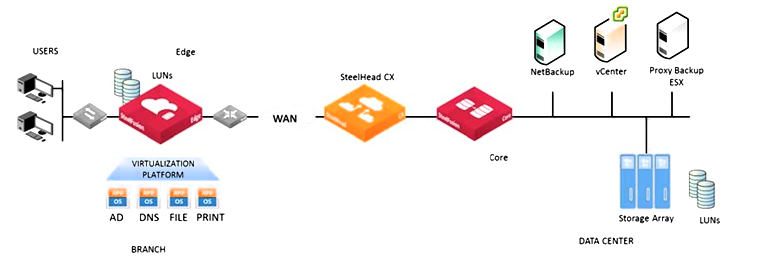About the Product
The product provides a converged infrastructure solution, encompassing all branch services such as server, storage, networking, and WAN optimization. It is a dual-ended system that comprises two logical components: Edge and Core.
Core is located in the data center and mounts all storage (LUNs) that need to be made available to applications and servers at a remote location from the back-end storage array. Core appliances communicate across the WAN with the Edge appliances at the branch.
The product delivers local user performance while enabling data centralization, instant recovery, and lower total operating costs. Unlike traditional converged infrastructures, The product enables stateless branch services. You can access applications that run locally in the branch while the primary data is centralized in the data center, allowing applications to run in a stateless mode.
You can extend a data center storage array to a remote location, even over a low-bandwidth link.
The product provides the following functionality:
• Innovative storage optimization ensures that you can centrally manage data storage while keeping that data available to business operations in the branch, even in the event of a WAN outage.
• A local authoritative cache ensures LAN-speed reads and fast cold writes at the branch.
• Integration with Microsoft Volume Shadow Copy Service enables consistent point-in-time data snapshots and seamless integration with backup applications.
• Integration with the snapshot capabilities of the storage array enables you to configure application-consistent snapshots through the Management Console.
• Integration with industry-standard Challenge-Handshake Authentication Protocol (CHAP) authenticates users and hosts.
• A secure vault protects sensitive information using AES 256-bit encryption.
• Solid-state disks (SSDs) that guarantee data durability and performance.
• An active-active high-availability (HA) deployment option for Core ensures the availability of storage for remote sites.
• Customizable reports provide visibility to key utilization, performance, and diagnostic information.
The product family simplifies infrastructure in remote offices and branch offices, and you manage it centrally from a data center. The product operates in iSCSI mode. iSCSI or Fibre Channel protocols interface with block storage arrays in the data center and iSCSI to host servers at the branch office. The product family is typically deployed in conjunction with SteelHeads and is composed of the following:
• Core—Is deployed in the data center alongside SteelHeads and a storage array. The Core mounts LUNs provisioned for the branch offices from a storage array and manages transfers between this storage and the Edges. Additionally, Core can mount LUNs via Fibre Channel.
• Edge—Edge refers to the branch component of the solution. The Edge hosts WAN optimization.
The Edge presents itself to application servers in the branch as an iSCSI storage portal. From the portal, the application server uses iSCSI to mount the iSCSI LUNs that are projected across the WAN from the data center. Edge can also host local LUNs for use as temporary storage that are not projected from the data center: for example, temporary or local copies of software repositories.
• LUN—A unique identifier associated with individual storage devices or collections of storage devices used with SCSI, iSCSI, or Fibre Channel interfaces.
• Branch server—The branch-side servers access data from the system instead of a local storage device.
• Blockstore—A persistent and authoritative local cache of storage on the Edge that caches the writes on LUNs presented by the Edge. Blockstore also stores cached portions of the LUNs to quickly serve read requests.
Typical deployment

The product initially populates the blockstore using these methods:
• First request—Data is added to the blockstore when first requested. The first request is subject to standard WAN latency because it is the first time the data is being served. Subsequent traffic is optimized. Reactive prefetch and policy-based prefetch minimizes these first requests.
• On-demand prefetch—Core observes block requests, intelligently predicts the data most likely to be requested in the near future, and then requests that data from the data center LUN in advance.
• Policy-based prefetch—Configured policies identify the data that is likely to be requested at a given branch office site in advance. The Edge then requests that data from the data center LUN in advance.
Data is transferred between Edges and Cores through an internal protocol. Core then writes the updates to the data center storage with the appropriate protocol. Optionally, you can further optimize traffic between the branch offices and the data center by implementing SteelHeads.
When the branch office server requests data, that data is served locally from the blockstore (unless it is not present, in which case Edge retrieves the data from the data center LUN via Core). Similarly, newly written data is spooled to the local cache, acknowledged by Edge to the branch office server, and then asynchronously propagated to the data center. Because each Edge implementation is linked to one or more dedicated LUNs at the data center, the blockstore is authoritative for both reads and writes and can tolerate WAN outages without affecting cache coherency.
Upgrades to future releases will be blocked if LUN-based snapshot policy is configured.


